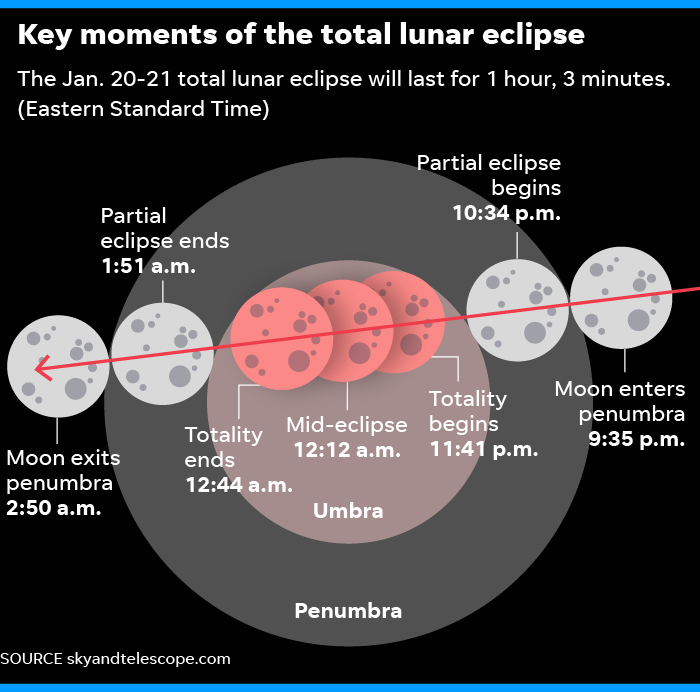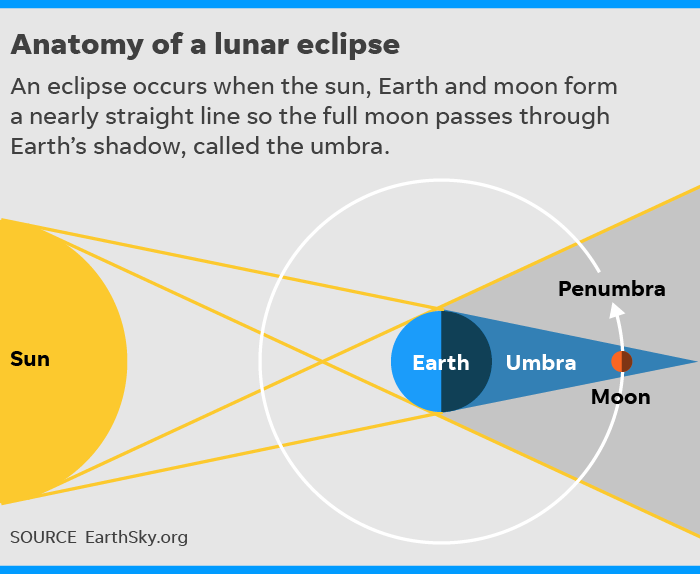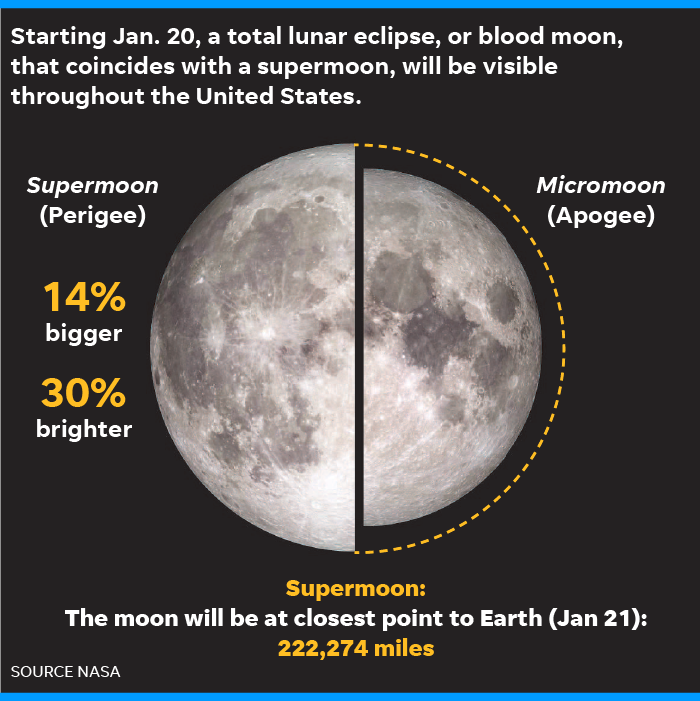Here's your guide to the 'super blood wolf moon eclipse' that's coming this weekend
 Doyle Rice
Doyle RiceSure, you may know the "super blood wolf moon eclipse" is coming to a sky near you this weekend. But what exactly does it mean?
Unquestionably, the main event is the total lunar eclipse, also known as an eclipse of the moon, which will start late Sunday, Jan. 20, and finish early Monday, Jan. 21 (Eastern time).
This type of eclipse happens when the moon passes fully into the shadow of Earth.
Beyond that, despite all the hullabaloo over the various names, there's still only one moon. There's no separate super, blood, wolf or anything else moon.
Start the day smarter:Get USA TODAY's Daily Briefing in your inbox
Here's some more info about this month's sky spectacle:
Total lunar eclipse: You'll have to stay up late for this event, so drink some coffee and grab some blankets.
A total lunar eclipse occurs when the moon and the sun are on exact opposite sides of Earth, according to NASA. When this happens, Earth blocks the sunlight that normally reaches the moon. Instead of that sunlight hitting the moon’s surface, Earth's shadow falls on it.

(Note: In this graphic above, there is nothing visibly different when the moon enters the penumbra at 9:35. The first shading on the moon won't appear until roughly 10:10.)
Starting at 10:34 p.m. EST Sunday, skywatchers will notice a "little notch is taken out of the moon," according to Brian Murphy, director of Indiana's Holcomb Observatory & Planetarium and Butler University professor. This is the beginning of the partial eclipse.
"The moon starts to enter into the Earth's shadow in a portion called the umbra when the sun is totally blocked out," he said. "Earth is moving from right to left through the shadow."

Starting at 11:41 p.m., the full eclipse will begin. A maximum eclipse will occur at 12:12 a.m. Monday. The total eclipse will end at 12:44 a.m.
Supermoon: A supermoon occurs when the full moon is at the closest point of its orbit to the Earth, which is also called the perigee.
That makes the moon look extra close and extra bright – up to 14 percent bigger and 30 percent brighter than a full moon at its farthest point from Earth, known as the apogee, NASA said.
This is the first of three supermoons in 2019. The others will be on Feb. 19 and March 21. Of these, the Feb. 19 full moon will be the closest and largest full supermoon of 2019.

"Blood" moon: That is just the reddish color the moon will appear during the total lunar eclipse. The moon won't turn black or vanish from the sky; instead it will appear to be a "reddish copper color," Murphy said, hence the name blood moon.
Although the moon is in Earth's shadow, some sunlight still reaches the moon. The sunlight passes through Earth's atmosphere, which causes our atmosphere to filter out most of the blue light.
This makes the moon appear red to people on Earth.
"Wolf" moon: According to the Old Farmer's Almanac, Native Americans called the January full moon the "wolf" moon because it appeared when wolves howled in hunger outside the villages.
The almanac said ancient peoples commonly tracked the seasons by following the lunar calendar (vs. today’s solar calendar).
For millennia, people across the world named the months after nature’s cues.
More:January 2019 lunar eclipse: How to watch the super blood wolf moon eclipse
More:The far side of the moon: What is it, why we might grow potatoes there
Full moon: Nothing special here: A full moon occurs every 29.5 days, so there have been a few billion full moons in Earth's history. This is just the moment when the bright side of the moon entirely faces the Earth.
Though the moon will be full precisely at 12:16 a.m. EST on Monday, according to space.com, it will still be plenty big through the rest of the night and for the next night or two. Just as it has for billions of years, the full moon will be visible to everyone around the world, barring clouds.
If you miss this month's total lunar eclipse, you have to wait until May 26, 2021, for the next one in the USA. The next partial lunar eclipse will be this summer, on July 16, but it will be visible only in Africa and portions of Asia.

Weather forecast: Of course, the big question about seeing the eclipse is if clouds will ruin the view. AccuWeather predicts that the best viewing conditions are expected across most of the southern tier of the U.S., where it will be mainly cloud-free.
A winter storm could ruin the view in parts of the East: "There is a potential for a major winter storm to impact the mid-Atlantic and Northeast [this] weekend that could last into Sunday night. If that happens, viewing the lunar eclipse is a no-go for residents in those regions,” AccuWeather meteorologist Mike Doll said.
Doll also expects clouds over much of the western U.S., but there could be enough breaks in the clouds for people to see the eclipse from Denver, Phoenix and San Francisco.
Even if skies are clear in the central U.S., bitter cold will be the main story. “It’s going to be very cold with temperatures in the single digits and teens in parts of the Midwest and Plains,” Doll said.
Contributing: Kellie Hwang, Indianapolis Star